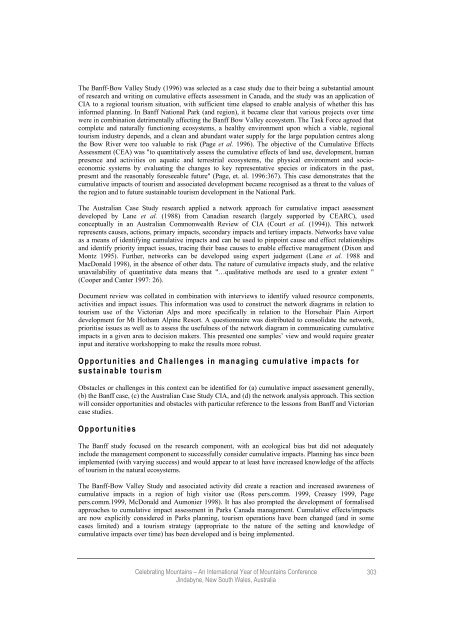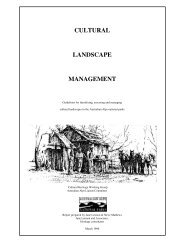LiteratureCumulative impacts (CI) are the effects on valued environmental component(s) that are additive in time,space and/or interact together (Cameron 2000 and Hegmann et al. 1998). Cumulative impact assessmentaims to take the longer and broader view to identify the possible total effect of decisions about a numberof seemingly isolated projects (Thomas 1998).A holistic or systems view of all elements (human and natural) is increasingly recognised as necessary fora sustainable approach to development generally (Odum 1982; Suzuki 1999), and in relation to tourismdevelopment (Carlsen 1998; Getz 1983; Gunn 1979). Systems theory was adapted to urban and regionalplanning (Chadwick 1971), and has been used to inform various models in relation to tourism planning(Getz 1983).Cumulative impacts have been recognised as an important issue in planning for sustainable tourism(Butler 2000; Buckley 1994; Court et al. 1994; Dowling 1993; Pearce et al. 1993; Wight 1994). Reviewof current practice reveals that there is considerable room for improvement in planning for tourism, theindustry with perhaps the most to lose from inadequate consideration of sustainability issues (Butler andWaldbrook 1991; Dredge 1997; Ecologically Sustainable Working Groups 1991; Hall, Jenkins andKearsley 1997; Hall and Lew 1998; Prosser 1991). The cumulative impacts of individual tourismdevelopments frequently threaten the ecological, economic and social “carrying capacity” of tourismareas and undermine the natural and social values that attract tourists. In many cases the planning andimpact assessment methods and processes currently in use are not effective in managing the cumulativeimpacts of all tourist enterprises to ensure the sustainability of the tourism resource (Buckley 1991; Butler2000; Harvey 1998; Hunter and Green 1995; McDonald 1999; Orians 1995; Rees 1988; Theobald 1994).Many tourism/recreation impacts take place in uncontrolled settings, posing problems for the traditionalscientific approach (of control population or site). Cause and effects can often only be surmised ratherthan proven. It is difficult or impossible to separate effects of tourism from those of other activities andprocesses of change (Butler 2000: 343).Impacts research needs to be more frequently incorporated into the management of tourism and recreationareas to minimise adverse consequences (Butler, in Pearce and Butler (eds.) 1993 and Butler 2000).Literature indicated that there is limited acknowledgement of cumulative impacts as being particularlycritical in tourism as well as very little research or method application in this area (Dredge 1998; Sun andWalsh 1998). Cumulative impact assessment (CIA) can play a role in management of current projects,allowing for future development, while also considering regional carrying capacity (Glasson, Theriveland Chadwick 1999; Rees 1988; Tollefson and Wipond 1999).ResearchResearch aimed to consider the relationship between tourism regions and cumulative impacts, as well ashow this knowledge can be included in planning so as to improve the sustainability of tourismdevelopment. Consideration of how cumulative impacts can be considered to achieve sustainable tourismwas investigated, through review of international cases, the Banff-Bow Valley Study, Canada (Greenet.al.1996) and application of a network approach to CIA in Mt Hotham Alpine Resort/Alpine <strong>National</strong>Park, Victoria, Australia. This involved information collation and investigation of research questionsusing a theoretical model framework (Getz 1986) and a combination of document analysis, case study,interviews, observations, and a questionnaire. This variety of methods was used to achieve reliability andvalidity of research results, in using qualitative methods (Leedy 1993; Minichiello et al. 1995).Getz (1986) proposed the “Integrative systems model of tourism theory and planning” be applied to theassessment of an areas capacity to absorb tourism. Central to the model is that the planner or decisionmakershould integrate understanding of the tourism system with control of the system. The incorporationof cumulative impacts in improving system understanding and planning is investigated throughapplication and adaption of the model.302Celebrating Mountains – An International Year of Mountains ConferenceJindabyne, New South Wales, Australia
The Banff-Bow Valley Study (1996) was selected as a case study due to their being a substantial amountof research and writing on cumulative effects assessment in Canada, and the study was an application ofCIA to a regional tourism situation, with sufficient time elapsed to enable analysis of whether this hasinformed planning. In Banff <strong>National</strong> Park (and region), it became clear that various projects over timewere in combination detrimentally affecting the Banff Bow Valley ecosystem. The Task Force agreed thatcomplete and naturally functioning ecosystems, a healthy environment upon which a viable, regionaltourism industry depends, and a clean and abundant water supply for the large population centres alongthe Bow River were too valuable to risk (Page et al. 1996). The objective of the Cumulative EffectsAssessment (CEA) was "to quantitatively assess the cumulative effects of land use, development, humanpresence and activities on aquatic and terrestrial ecosystems, the physical environment and socioeconomicsystems by evaluating the changes to key representative species or indicators in the past,present and the reasonably foreseeable future" (Page, et. al. 1996:367). This case demonstrates that thecumulative impacts of tourism and associated development became recognised as a threat to the values ofthe region and to future sustainable tourism development in the <strong>National</strong> Park.The <strong>Australian</strong> Case Study research applied a network approach for cumulative impact assessmentdeveloped by Lane et al. (1988) from Canadian research (largely supported by CEARC), usedconceptually in an <strong>Australian</strong> Commonwealth Review of CIA (Court et al. (1994)). This networkrepresents causes, actions, primary impacts, secondary impacts and tertiary impacts. Networks have valueas a means of identifying cumulative impacts and can be used to pinpoint cause and effect relationshipsand identify priority impact issues, tracing their base causes to enable effective management (Dixon andMontz 1995). Further, networks can be developed using expert judgement (Lane et al. 1988 andMacDonald 1998), in the absence of other data. The nature of cumulative impacts study, and the relativeunavailability of quantitative data means that "…qualitative methods are used to a greater extent "(Cooper and Canter 1997: 26).Document review was collated in combination with interviews to identify valued resource components,activities and impact issues. This information was used to construct the network diagrams in relation totourism use of the Victorian <strong>Alps</strong> and more specifically in relation to the Horsehair Plain Airportdevelopment for Mt Hotham Alpine Resort. A questionnaire was distributed to consolidate the network,prioritise issues as well as to assess the usefulness of the network diagram in communicating cumulativeimpacts in a given area to decision makers. This presented one samples’ view and would require greaterinput and iterative workshopping to make the results more robust.Opportunities and Challenges in managing cumulative impacts forsustainable tourismObstacles or challenges in this context can be identified for (a) cumulative impact assessment generally,(b) the Banff case, (c) the <strong>Australian</strong> Case Study CIA, and (d) the network analysis approach. This sectionwill consider opportunities and obstacles with particular reference to the lessons from Banff and Victoriancase studies.OpportunitiesThe Banff study focused on the research component, with an ecological bias but did not adequatelyinclude the management component to successfully consider cumulative impacts. Planning has since beenimplemented (with varying success) and would appear to at least have increased knowledge of the affectsof tourism in the natural ecosystems.The Banff-Bow Valley Study and associated activity did create a reaction and increased awareness ofcumulative impacts in a region of high visitor use (Ross pers.comm. 1999, Creasey 1999, Pagepers.comm.1999, McDonald and Aumonier 1998). It has also prompted the development of formalisedapproaches to cumulative impact assessment in <strong>Parks</strong> Canada management. Cumulative effects/impactsare now explicitly considered in <strong>Parks</strong> planning, tourism operations have been changed (and in somecases limited) and a tourism strategy (appropriate to the nature of the setting and knowledge ofcumulative impacts over time) has been developed and is being implemented.Celebrating Mountains – An International Year of Mountains ConferenceJindabyne, New South Wales, Australia303
- Page 2 and 3:
200Celebrating Mountains - An Inter
- Page 5:
Cultural ContextThe southern margin
- Page 8 and 9:
206Celebrating Mountains - An Inter
- Page 10 and 11:
Broom In The Australian Alps Introd
- Page 12 and 13:
Tumut workshop The English broom wo
- Page 14 and 15:
212Celebrating Mountains - An Inter
- Page 16 and 17:
Natural area tourismTourism is the
- Page 18 and 19:
(bare areas and weed cover) per km
- Page 20 and 21:
McDougall, K.L. and Appleby, ML. (2
- Page 22 and 23:
As the demand for fresh water incre
- Page 24 and 25:
Mountain Catchment Biomes As with m
- Page 26 and 27:
ReferenceDavis, S.D., Heywood, V.H.
- Page 28 and 29:
KNP Package, are designed to provid
- Page 30 and 31:
General environmental managementFor
- Page 32 and 33:
Former Snowy Scheme Sites The corpo
- Page 34 and 35:
232Celebrating Mountains - An Inter
- Page 36 and 37:
Map 1 - The Main Range showing the
- Page 38 and 39:
The freeze-thaw cycle also disturbs
- Page 40 and 41:
the Main Range between Dead Horse G
- Page 42 and 43:
The landscape has been stabilised,
- Page 44 and 45:
Kosciusko State Park Trust, 1963. P
- Page 46 and 47:
244Celebrating Mountains - An Inter
- Page 48 and 49:
ottom line approach whereby social,
- Page 50 and 51:
Parks Victoria have a general “He
- Page 52 and 53:
ReferencesConservation and Environm
- Page 54 and 55: over the past 200 years and a measu
- Page 56 and 57: During the 2000 ski season, approxi
- Page 58 and 59: Several studies have been undertake
- Page 60 and 61: Mt Hotham ResortA pilot ultrafiltra
- Page 62 and 63: REFERENCESJacangelo, J., Adham, S.
- Page 64 and 65: Kosciuszko National Park attracts a
- Page 66 and 67: improvements are ongoing. An EMS Op
- Page 68 and 69: All stakeholders are responsible fo
- Page 70 and 71: 268Celebrating Mountains - An Inter
- Page 72 and 73: market and invite feedback from the
- Page 74 and 75: 272Celebrating Mountains - An Inter
- Page 76 and 77: foundation for a variety of income
- Page 78 and 79: noted above, often visitors will re
- Page 80 and 81: experiences that are provided are r
- Page 82 and 83: Importance of Benefits by SegmentIm
- Page 84 and 85: Literature CitedBorrie, W. T. and R
- Page 86 and 87: simply not receiving the leaflets.
- Page 88 and 89: 5. American researchers had examine
- Page 90 and 91: Formative EvaluationBetween Februar
- Page 92 and 93: The two-part directive is short, al
- Page 94 and 95: ReferencesAjzen, I., 1991, The Theo
- Page 96 and 97: .294Celebrating Mountains - An Inte
- Page 98 and 99: Within the CRC ST there are seven p
- Page 100 and 101: SummerTourismSummerVisitor UsageAlp
- Page 102 and 103: References AALC See Australian Alps
- Page 106 and 107: There are still conflicts in relati
- Page 108 and 109: Some of the challenges inherent in
- Page 110: Minichiello V, A. R., Timewell E, a
















